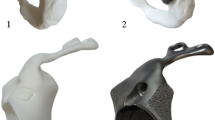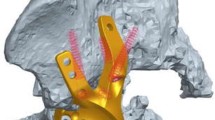Abstract
Background
Pelvic discontinuity causes severe destruction of the acetabular bony walls and is particularly difficult to manage. This article reports the short-term results and complications encountered in the management of loosening of the acetabular cup with pelvic discontinuity using an acetabular cup with an intramedullary iliac stem combined with an extramedullary iliac plate.
Material and methods
As part of this monocentric retrospective case analysis all patients who underwent acetabular revision surgery after THR due to loosening of the acetabular cup with pelvic discontinuity in this clinic from January 2016 to June 2017 were identified (n = 16). All patients underwent routine clinical and radiological follow-up. In addition, the Harris hip score (HHS) and the Western Ontario and McMaster Universities osteoarthritis index (WOMAC) were evaluated as part of a 1-year follow-up.
Results
All patients were treated with an acetabular revision cup of appropriate size with intramedullary iliac stem combined with an anatomical extramedullary iliac plate. On clinical follow-up at 1 year (median follow-up time 14.5 ± 3.3 months), the average HHS was 69.3 ± 14.1 and the average WOMAC was 79.3 ± 11.7. Complications were registered in 7 out of the 16 patients whereby 1 showed aseptic loosening of the revision cup, dislocations were reported in 4 cases and infections in 2 cases. In the case of the two patients with infections a Girdlestone resection arthroplasty had to be performed.
Conclusion
The overall complications and postoperative outcome in revision surgery after THR reported in the literature were compared to the results of this study. Compared to the results of salvage procedures using large or bipolar heads and Girdlestone resection arthroplasty, satisfactory results were obtained using the acetabular cup with an intramedullary iliac stem combined with an extramedullary iliac plate.
Zusammenfassung
Einführung
Die Beckendiskontinuität umfasst eine schwerwiegende Beeinträchtigung der Azetabulumpfeiler und ist besonders schwer zu behandeln. In dieser Arbeit wird über die kurzfristigen Ergebnisse und Komplikationen berichtet, die bei der Verwendung einer Revisionspfanne mit Lasche und Darmbeinzapfen zur Behandlung der Lockerung der Hüftpfanne mit Beckendiskontinuität auftreten.
Material und Methoden
Im Rahmen dieser monozentrischen retrospektiven Fallanalyse; von Januar 2016 bis Juni 2017 wurden alle Patienten eingeschlossen (n = 16), bei denen nach einer THR aufgrund einer Lockerung der Hüftgelenkpfanne mit Becken-Diskontinuität eine Hüftgelenkrevisionsoperation durchgeführt wurde. Alle Patienten wurden regelmäßig klinisch und radiologisch untersucht. Darüber hinaus wurden der Harris-Hip-Score (HHS), der Western Ontario und der McMaster Universities Osteoarthritis Index (WOMAC) im Rahmen eines einjährigen Follow-up ausgewertet.
Ergebnisse
Alle Patienten wurden mittels einer Revisionspfanne mit anatomischer Lasche und Darmbeinzapfen in geeigneter Größe behandelt. Bei der klinischen Nachuntersuchung nach einem Jahr (mittlere Nachbeobachtungszeit: 14,5 ± 3,3 Monate) betrug der durchschnittliche HHS 69,3 ± 14,1 und der durchschnittliche WOMAC-Wert 79,3 ± 11,7. Bei 7 von 16 Patienten gab es Komplikationen. In einem Fall zeigte sich eine aseptische Lockerung der Revisionspfanne. In 4 Fällen wurden Pfannendislokationen gesehen, und in 2 Fällen traten Infektionen auf. Bei den beiden Patienten mit Infektionen musste eine Girdlestone-Resektionsarthroplastik durchgeführt werden.
Schlussfolgerung
Im Vergleich zu den Gesamtkomplikationen und den postoperativen Ergebnissen bei Revisionsoperationen nach THR, die in der Literatur berichtet werden und im Vergleich zu den Ergebnissen von Salvage-Prozeduren mit großen oder bipolaren Köpfen und Girdlestone-Resektionsarthroplastiken waren die Ergebnisse bei der Verwendung der Revisionspfanne mit anatomischer Lasche und Darmbeinzapfen zufriedenstellend.


Similar content being viewed by others
Change history
08 March 2019
<Emphasis Type="Bold">Erratum to:</Emphasis>
<Emphasis Type="Bold">Orthopäde 2018</Emphasis>
<ExternalRef><RefSource>https://doi.org/10.1007/s00132-018-03675-5</RefSource><RefTarget Address="10.1007/s00132-018-03675-5" TargetType="DOI"/></ExternalRef>
Dear Reader,
in the original online version of the article “Management of pelvic discontinuity in revision hip arthroplasty using a cementless acetabular cup with an iliac stem in combination with a cranial strap” in the section …
Abbreviations
- AAOS:
-
American Academy of Orthopaedic Surgeons
- ASA:
-
American Society of Anaesthesiologists
- CT:
-
Computed tomography
- EPRD:
-
German endoprosthesis register
- HHS:
-
Harris hip score
- ICD 10:
-
International classification of diseases 10
- SOP:
-
Standard operating procedure
- THR:
-
Total hip replacement
- WOMAC:
-
Western Ontario and McMasters Universities osteoarthritis index
References
AQUA – Institut für angewandte Qualitätsförderung und Forschung im Gesundheitswesen (2012) Hüftendoprothesenversoegung – Abschlussbericht. AQUA, Göttingen
Amenabar T, Rahmann WA, Hetaimish BM et al (2016) Promising mid-term results with a cup-cage construct for large acetabular defects and pelvic discontinuity. Clin Orthop Relat Res 474:408–414
D’Antonio JA, Capello WN, Borden LS et al (1989) Classification and management of acetabular abnormalities in total hip arthroplasty. Clin Orthop Relat Res 243:126
Demir M, Pirincci Y, Salih M, Erdogan F, Güney N (2015) The midterm and long-term effects of acetabular roof ring and Burch-Schneider anti-protrusio cages in acetabular revisions for patients with acetabular bone deficiency. Acta Orthop Traumatol Turc 49(6):597–605
Endoprothesenregister Deutschland (2016) EPRD Jahresbericht 2016. https://www.eprd.de/fileadmin/user_upload/Dateien/Publikationen/Berichte/EPRD-Jahresbericht_2016_Einzelseiten_Online-Version.pdf Zugegriffen: 24.10.2017
Ghanem M, Glase A, Zajonz D, Roth A, Heyde CE, Josten C, von Salis-Soglio G (2016) Bipolar hip arthroplasty as salvage treatment for loosening of the acetabular cup with significant bone defects. GMS Interdiscip Plast Reconstr Surg DGPW 5:Doc13
Gill TJ, Sledge JB, Müller ME (1998) The Burch-Schneider anti-protrusio cage in revision total hip arthroplasty: indications, principles and long-term results. J Bone Joint Surg 80:946
Gollwitzer H, von Eisenhart-Rothe R, Holzapfel BM, Gradinger R (2010) Revisionsendoprothetik. Chirurg 81(2010):284–292. https://doi.org/10.1007/s00104-009-1845–2
Hoberg M, Holzapfel BM, Steinert AF, Kratzer F, Walcher M, Rudert M (2017) Defektadaptierte Versorgung azetabulärer Knochendefekte mit dem Revisio-System. Orthopade 46:126–132. https://doi.org/10.1007/s00132-016-3375-1
Ilchmann T, Gelzer JP, Winter E, Weise K (2006) Acetabular reconstruction with the Bruch-Schneider ring: an EBRA analysis of 40 cup revision. Acta Orthop 77(1):79–86. https://doi.org/10.1080/17453670610045722
Ilyas I, Alrumaih HA, Kashif S, Rabbani SA, Faqihi AH (2015) Revision of type III and IVB acetabular defects with Burch-Schneider anti-Protrusio cages. J Arthroplasty 30:259–264
Jafari SM, Bender B, Coyle C et al (2010) Do tantalum and titanium cups show similar results in revision hip arthroplasty. Clin Orthop Relat Res 468:459–465
Jones L, Grammatopoulos G, Singer G (2012) The Burch-Schneider cage: 9‑year survival in Paprosky typ 3 acetabular defects. Clinical and radiological follow-up. Hip Int 22:28
Lamo-Espinosa J, Duart Clemente J, Diaz-Rada P et al (2013) The Burch-Schneider antiprotusio cage: medium follow-up results. Musculoskelet Surg 97:31
Paprosky WG, Perona PG, Lawrence JM (1994) Acetabular defect classification and surgical reconstruction in revision arthroplasty. A 6‑year follow-up evaluation. J Arthroplasty 9:33–44
Paprosky W, Sporer S, O’Rourke MR (2006) The treatment of pelvic discontinuity with acetabular cages. Clin Orthop Relat Res 453:183
Peters CL, Curtain M, Samuelson KM (1995) Acetabular revision with the Bruch-Schneider antiprotrusio cage and cancellous allograft bone. J Arthroplasty 10:307
Pieringer H, Auersperg V, Böhler N (2006) Reconstruction of servere acetabular bone-deficiency. J Arthroplasty 21(4):489–96
Regis D, Magnan B, Sandri A et al (2008) Long-term results of anti-protrusion cage and massive allografts for the management of periprosthetic acetabular bone loss. Arthroplasty 23:826
Regis D, Sandri A, Bonetti I et al (2012) A minimum of 10-year follow-up of the Burch-Schneider cage and bulk allografts for the revision of pelvic discontinuity. Arthroplasty 27:1057
Swedish hip arthroplasty register. Annual report 2015. https://registercentrum.blob.core.windows.net/shpr/r/Annual-Report-2015-H19dFINOW.pdf Zugegriffen: Dezember 2016
Symeonides PP, Petsatodes GE, Pournaras JD (2009) The effectiveness of the Burch-Schneider antiprotrusio cage for acetabular bone deficiency; five to twenty-one years follow-up. J Arthroplasty 24:168
Taunton MJ, Fehring TK, Edwards P et al (2012) Pelvic discontinuity treated with custom triflange component: a reliable option. Clin Orthop Relat Res 470:428–434
Tennison LM, Bishoy VG, Karim AE, Carlos AH (2015) Complication, survival and reoperation rates following girdlestone resection arthroplasty. J Arthroplasty 30:1183–1186
van Koeveringe AJ, Ochsner PE (2002) Revision cup arthroplasty using Burch-Schneider anti protrusio cage. Int Orthop 26:291
Wassilew GI, Janz V, Perka C, Müller M (2017) Defektadaptierte azetabuläre Versorgung mit der Trabecular-Metal-Technologie. Orthopade 46:148–157. https://doi.org/10.1007/s00132-016-3381-3
Winter E, Piert M, Volkmann R et al (2001) Allogeneic cancellous bone graft and a Bruch-Schneider cage for acetabular reconstruction in revision hip arthroplasty. J Bone Joint Surg Am 83–A:862
Author information
Authors and Affiliations
Corresponding author
Ethics declarations
Conflict of interest
M. Ghanem, D. Zajonz, R. Nuwayhid, C. Josten, C.-E. Heyde and A. Roth declare that they have no competing interests.
Prior to the start of the investigation, the ethics committee of the local university was consulted. After examination a positive vote was issued. The vote number of the audit authority is 366/16-ek. All procedures reported in this article were in accordance with the ethical standards of the institutional and/or national research committee and with the 1964 Helsinki declaration and its later amendments or comparable ethical standards. Informed consent was obtained from all subjects described in this article.
Additional information
The original version of this article was revised: a wrong vote number of the audit authority was accidentally given.
Rights and permissions
About this article
Cite this article
Ghanem, M., Zajonz, D., Nuwayhid, R. et al. Management of pelvic discontinuity in revision arthroplasty. Orthopäde 48, 413–419 (2019). https://doi.org/10.1007/s00132-018-03675-5
Published:
Issue Date:
DOI: https://doi.org/10.1007/s00132-018-03675-5




